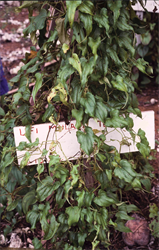- Widespread. Present wherever Dioscorea alata and other species is grown.
- Impact unknown. Caused by Yam mild mosaic virus, second most important after Yam mosaic virus disease (see Fact Sheet no. 526). Symptoms vary: leaves with mild yellowing, yellow and green spots, mottles and mosaics, severe leaf distortions and stunting.
- Spread: aphids by flight and on the wind. Transmission in non-persistent manner - aphids acquire YMMV quickly, transmit it over next few hours, then lose ability to infect. Spreads also in sets for propagation.
- Biosecurity: risk from unofficial introductions, trade in yams, and possibility of different strains.. Official movement of germplasm should always follow the FAO/IPBGR Technical Guidelines.
- Biocontrol: none.
- Cultural control: choose only healthy (often largest) tubers for sets; rogue plants that show early symptoms to prevent them being used as sets next season. Weed to remove infestations of aphids; collect and destroy or eat undersized tubers at harvest. Resistant lines may be available through international breeding programs.
- Chemical control: not appropriate for this disease.
Pacific Pests, Pathogens and Weeds - Online edition
Pacific Pests, Pathogens, Weeds & Pesticides
Yam mild mosaic virus disease (530)
Yam mild mosaic
Yam mild mosaic virus; previously known as Dioscora alata virus, Yam virus 1. The virus belongs to the genus Potyvirus. The particles are flexuous rods. Likely, there are two related groups of YMMV, one from Africa and the other from Southeast Asia, sharing a common ancestor. The abbreviation is YMMV.
AUTHOR Grahame Jackson
Information from Kenyon L, et al. (2001) An overview of viruses infecting Dioscorea yams in Sub-Saharan Africa. In: Proceedings of a conference on Plant Virology in Sub Saharan Africa, 4-8 June 2001, Ibadan, Nigeria.(https://www.researchgate.net/publication/216088409_An_overview_of_viruses_infecting_Dioscorea_yams_in_Sub-Saharan_Africa); Brunt AA, et al. (eds) (1989) FAO/IBPGR Technical Guidelines for the Safe Movement of Yam Germplasm. Food and Agriculture Organization of the United Nations, Rome/International Board for Plant Genetic Resources, Rome. (http://ecoport.org/Resources/Refs/IPGRI/yam.pdf); and Naidu RA, Hughes JDA (2003) Methods for the detection of plant virus diseases. In: Proceedings of a conference on Plant Virology in Sub Saharan Africa, 4-8 June 2001, Ibadan, Nigeria, (pp. 233-253). (https://cgspace.cgiar.org/handle/10568/96508); and Luo GF, et al. (2021) A review of viruses infecting yam (Disoscoea spp): implications for safe exchange of Pacific yam germplasm. Viruses 13; and Yam mild mosaic virus (2021) Crop Protection Compendium. CABI. (https://www.cabi.org/cpc/datasheet/19292); and Umber M, et al. (2020) Molecular virus diagnostics and sanitation of yam genetic resources: Implications for safe yam germplasm exchange. Viruses 12: 1101. (https://www.mdpi.com/1999-4915/12/10/1101); and from Lopes-Montes A, et al. (2012) Yam breeding at IITA: achievements, challenges, and propsects. Research for development review. (https://biblio1.iita.org/bitstream/handle/20.500.12478/1579/U12ArtLopezmontesYamNothomNodev.pdf?sequence=1&isAllowed=y/).
Produced with support from the Australian Centre for International Agricultural Research under project HORT/2016/185: Responding to emerging pest and disease threats to horticulture in the Pacific islands, implemented by the University of Queensland, in association with the Pacific Community.




